Pickleball Court Dimensions – A Comprehensive Guide
Standard Pickleball court dimensions
Pickleball is one of the fastest-growing sports in the United States, and understanding its court dimensions is crucial for both new and experienced players. The standard pickleball court dimensions are 20 feet wide by 44 feet long (approximately 6.1 meters by 13.41 meters). These compact dimensions create an environment where agility and quick reflexes become vital, making it accessible and enjoyable for players of all skill levels.

Compared to the spacious setting of a tennis court, which is 27 feet wide for singles play and 36 feet wide for doubles play, and 78 feet long, a pickleball court is significantly smaller. This smaller size means that players remain closer to the action, which often results in faster and more dynamic gameplay. Consider it akin to comparing a cozy neighborhood park against a sprawling suburban green space – both have their charm, but they cater to very different needs.
Moreover, the compactness fosters an environment where players of all ages, from young kids to older adults, can participate without the strenuous physical demands of larger courts.
Court lines and markings
The layout of a pickleball court covers more than just dimensions – it’s meticulously structured with specific lines and markings essential for gameplay. The court is divided into two halves by a net that stands 36 inches high at the sidelines and 34 inches high at the center. These varying net heights are crucial as they add an element of skill and challenge, especially when executing serves and volleys.
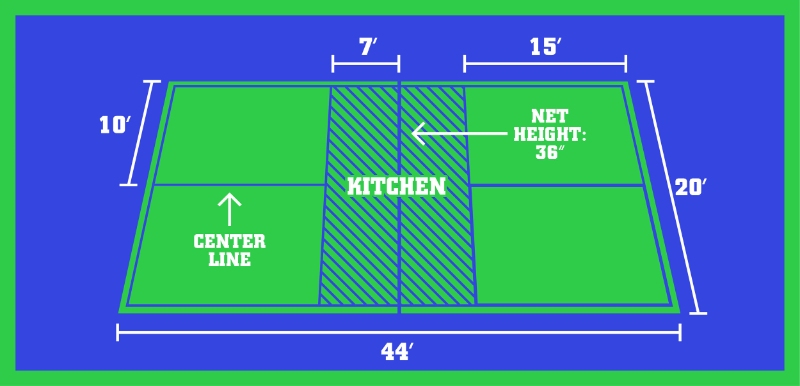
Each half of the court contains a non-volley zone, commonly referred to as the "kitchen," which extends 7 feet from the net on both sides. This area is pivotal in the game since it prevents players from executing smashes too close to the net, thereby encouraging strategic play over brute strength.
Further, the court includes baselines and sidelines that outline the playing area. There’s also a centerline running perpendicular to the net and dividing the service zones, which are 15 feet deep on each side. These markings play a vital role in serving, returning, and overall positioning during each match. It’s akin to the intricate lines on a football field that dictate various plays and strategies.
The net and posts
Attention to detail extends to the net and posts used in a standard pickleball court. The net itself should be at least 20 feet long and made of mesh with sufficiently small openings to prevent the ball from slipping through. The net is stabilized in the center by an adjustable strap, maintaining the required height of 34 inches at the center and 36 inches at the sides.
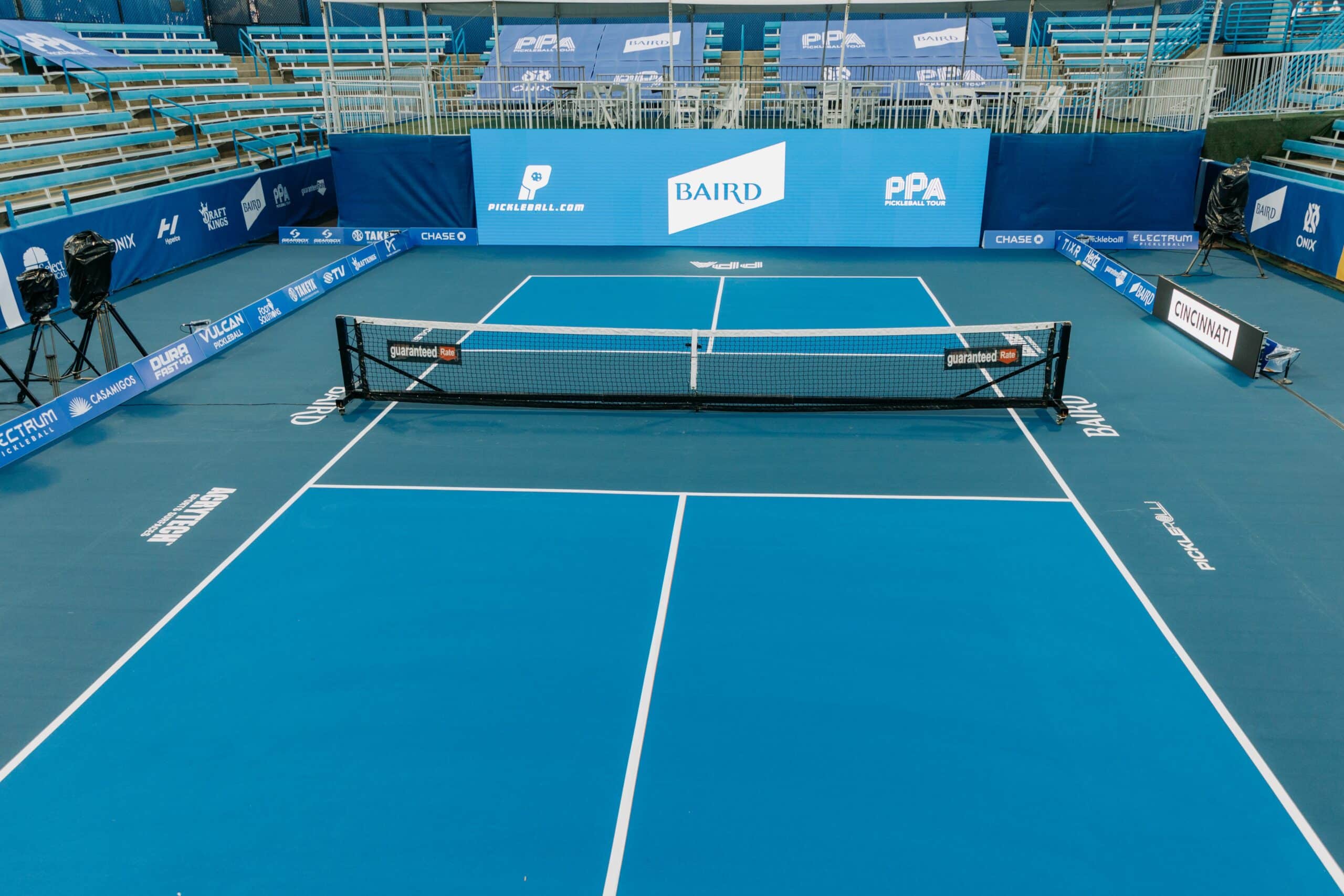
The net posts are essential for the tautness and positioning of the net and should be placed approximately 12 inches past the sidelines. This strategic placement ensures that the entire playing area remains free from obstructions. The net is attached to these posts through a cord or cable running through a 2-inch white binding across the top of the net, thereby ensuring stability and proper alignment.
When constructing a pickleball court, adhering to these specific dimensions and layout guidelines – as recommended by organizations like the USA Pickleball Association – ensures the court meets regulation standards. This, in turn, allows for consistent and fair gameplay, just like following a recipe to ensure the perfect cake every time.
Court composition and materials
Surface types
The type of surface on which pickleball is played can significantly influence the game’s pace and players’ comfort. In the United States, the most common pickleball court surfaces include:
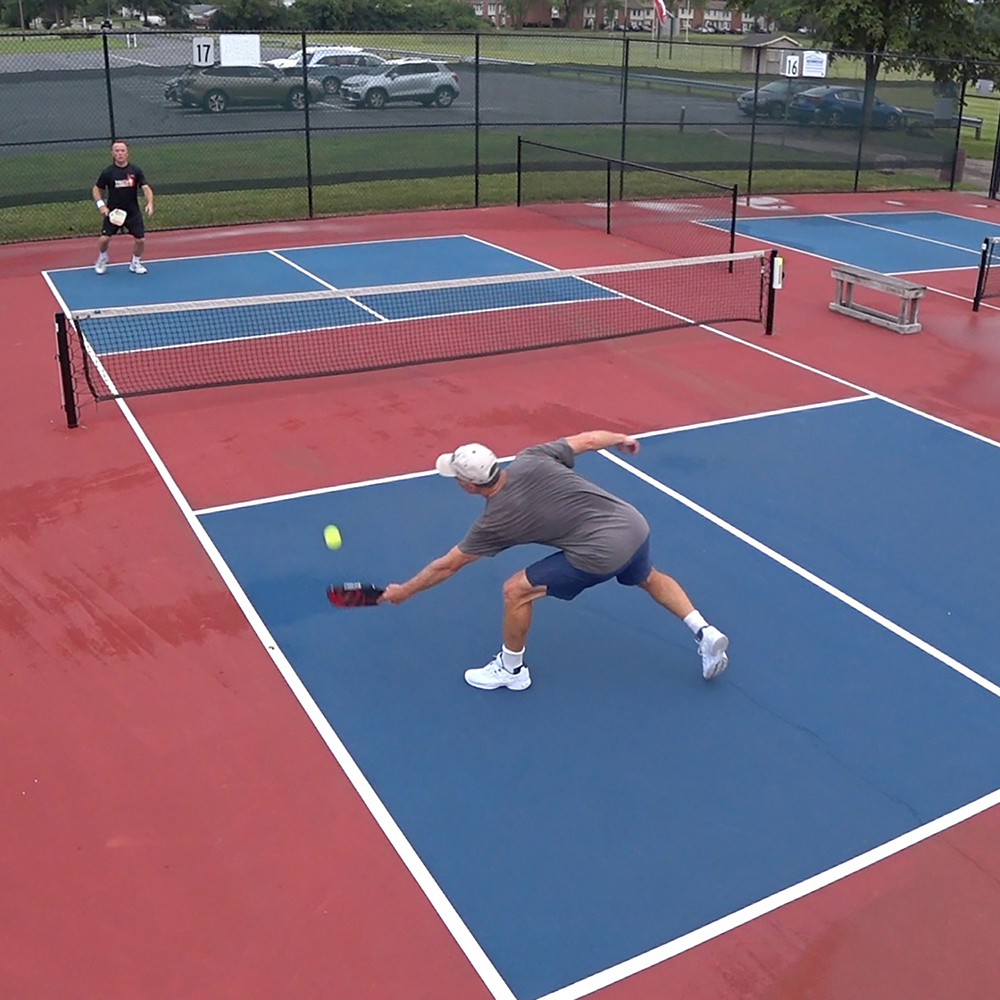
- Concrete: Known for its durability and level surface, concrete is a popular choice but requires additional acrylic coatings for cushioning and traction. Think of it as laying a solid foundation but needing the softness of a good carpet to make it comfortable.
- Asphalt: Another durable option, asphalt can withstand heavy use and weather variations. However, like concrete, it benefits from paint coatings for better traction. This material is preferred for outdoor courts given its robustness.
- Acrylotex: A custom surface applied over concrete or asphalt to offer a cushioned, textured playing area. This type enhances comfort and reduces the risk of injury, perfect for those who seek a less challenging surface for joints.
- Polyurethane: A go-to for indoor courts, this material provides a cushioned and durable playing surface, making it easier on the knees.
- Clay: Although less common in the US, clay courts are more forgiving and generally used in Europe and South America. They provide a slower-paced game, ideal for players who enjoy lengthy rallies.
- Grass: A rare sight for pickleball courts, grass may be used for temporary, casual games but requires higher maintenance and offers less stable footing.
These surface variations mean that players might experience different games depending on where they play. Like switching from running on pavement to a springy indoor track, each surface provides its unique feel and requires slight adjustments in gameplay.
Fencing and netting
Proper fencing and netting are essential components of a well-maintained pickleball court. The main purpose of fencing is to keep the game contained and reduce the risk of injuries caused by stray balls.
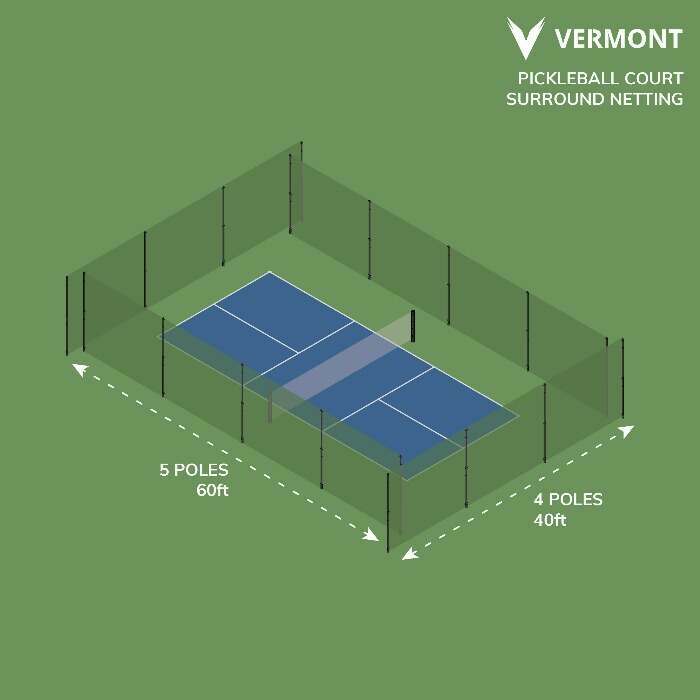
Recommended fence heights typically range between 8 to 10 feet. This height is a result of meticulous testing and observation, ensuring that it’s high enough to keep balls from flying out while not obstructing visibility.
Fence materials include:
- Chain-link fencing: Commonly used due to its durability and cost-effectiveness.
- Vinyl-coated fencing: Provides additional durability and a cleaner look.
- Aluminum fencing: Known for being rust-resistant and lightweight.
- Wrought iron fencing: Offers an elegant appearance and extreme durability but at a higher cost.
In terms of netting, the standard pickleball net is 20 feet long, with the same height specifications mentioned earlier: 36 inches at the sidelines and 34 inches at the center.
Together, the optimal fencing and netting contribute significantly to the playing environment, keeping it safe and organized. This setup is much like the well-constructed boundaries of a playground, designed to keep children safe while they play.
Court size variations and measurements
Comparisons with other courts
Knowing the dimensions of a pickleball court is useful, but understanding how it compares to other courts can provide more context:
Tennis Court:
- A standard tennis court for singles measures 27 feet wide.
- For doubles, it’s broader, measuring 36 feet wide.
- Both configurations keep the length constant at 78 feet.
- This makes a pickleball court roughly a quarter the size of a tennis court.
Read more: Pickleball court vs Tennis court
Volleyball Court:
- Measures 29.5 feet wide by 59 feet long.
- A single pickleball court can fit more comfortably within these dimensions, highlighting how much smaller pickleball courts are. This is similar to how a single studio apartment could fit comfortably within the living room of a spacious house.
Basketball Court:
- Standard dimensions are 50 feet wide by 94 feet long.
- Within this area, you could fit up to three standard pickleball courts, underscoring the compact nature of pickleball play areas.
Ice Hockey Rink:
- Measures 85 feet wide by 200 feet long.
- Six pickleball courts can fit into this expansive space. The vast difference in size is akin to comparing an Olympic swimming pool to a home backyard pool.
Badminton Court:
One key aspect of badminton is the difference in court dimensions for singles and doubles play:
- Singles court: Typically measures 17 feet by 44 feet.
- Doubles court: Expands to 20 feet by 44 feet.
While the length remains constant, the width is extended in doubles play to accommodate the extra players, which significantly impacts the tactics and spatial awareness required.
Read more: Pickleball court vs Badminton court
The smaller dimensions make pickleball courts more versatile in terms of where they can be set up, whether in parks, backyards, or other previously underutilized spaces.
Adjustments for different play spaces
While standard pickleball courts have specific dimensions, adjustments can be made for different play spaces to make the most out of available areas:
Backyard Courts:
- May not always conform to the 20 x 44 feet standards.
- Creative adjustments, such as slightly shorter lengths or widths, can still provide a playable surface.
Multiple Courts:
- Using a large space like a converted warehouse or gym can allow for several smaller courts side by side.
- Dimensions might be tweaked slightly, but keeping the key elements like the non-volley zone and service areas proportional ensures a regulation experience.
Temporary Courts:
- Chalk lines or temporary markers can create makeshift courts in versatile spaces like parking lots or community centers.
- Flexibility in dimensions is often required, but adherence to the overall layout principles remains important.
These flexible adjustments ensure that pickleball can be played almost anywhere, enhancing its popularity and accessibility, much like how street basketball thrives in urban settings.
Marking a pickleball court onto a tennis court
Marking out one pickleball court
Marking a single pickleball court onto a pre-existing tennis court isn’t just about slapping down lines—it requires precision and careful measurement. Here’s a step-by-step guide on how to do it:
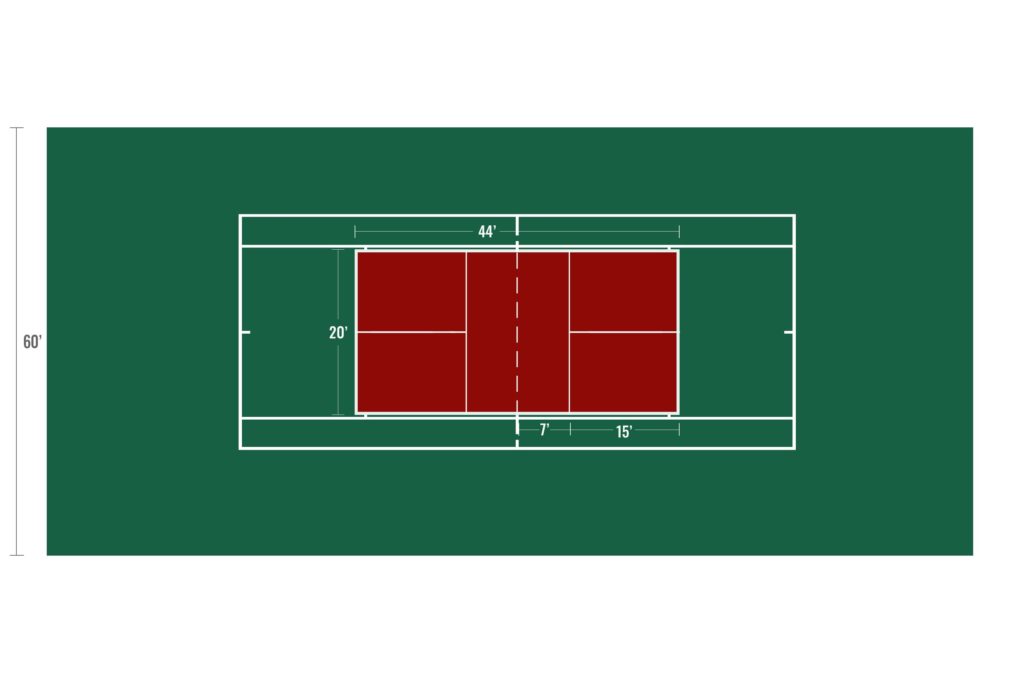
- Create a Straight 44-foot Line: Measure from point A to point B on a flat surface of the tennis court.
- Measure a 20-foot Line: From point A, stretch a measuring tape 20 feet wide (AC) and align it perpendicularly.
- Use Multiple Tape Measures: Measure from point B to C (about 48.33 feet) to ensure accurate distances.
- Apply Marking Tape: Use marker tape in a bright color (white, yellow, or orange) for better visibility. This is akin to drawing a blueprint before constructing a building—it sets the stage for precision.
- Double-Check: Make sure all lines are straight and markings are accurate before finalizing them with exterior acrylic paint.
By marking these, you maintain official dimensions (20 feet x 44 feet) within the larger tennis court, ensuring regulation compliance and optimal playability.
Marking out two pickleball courts
When marking two pickleball courts on one tennis court, precision becomes even more crucial to ensure each court retains regulation dimensions while fitting comfortably within the larger space:
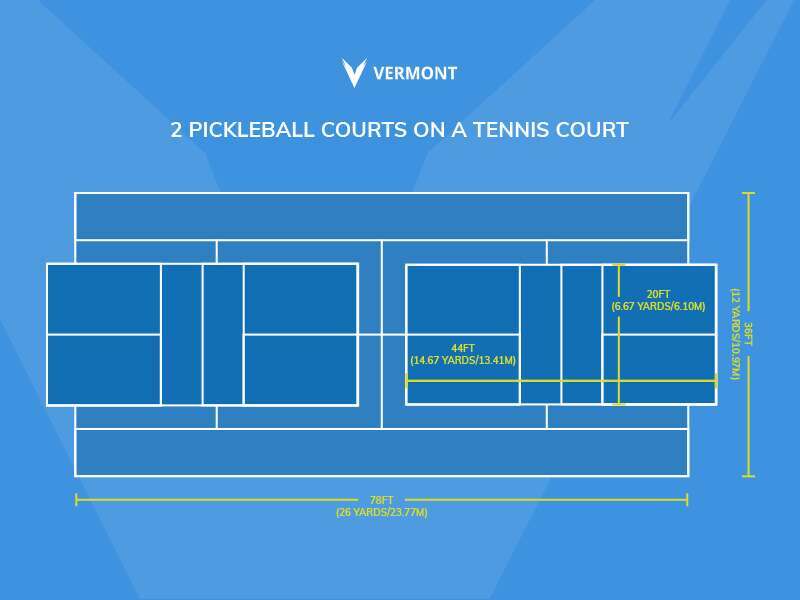
- Overall Layout Dimensions: The tennis court spans about 60 feet x 120 feet, generously fitting four pickleball courts.
- Start with Baselines: Mark the baselines and sidelines of the first court, following a 44-foot line from A to B.
- Measure Sidelines: From A to C, measure a 20-foot perpendicular line. Continue from B to C (48.33 feet) to connect and establish point C.
- Repeat for Second Court: Mark the second court mirroring the first on the opposite side of the tennis court.
Ensure safety and playability by using 2-4 inch wide marking tape, bright-hued, with straight and accurate lines. This mirrors the meticulous planning of urban spaces, ensuring usability and aesthetics.
Marking out four pickleball courts
To mark four pickleball courts on a single tennis court requires strategic spacing and attention to detail:
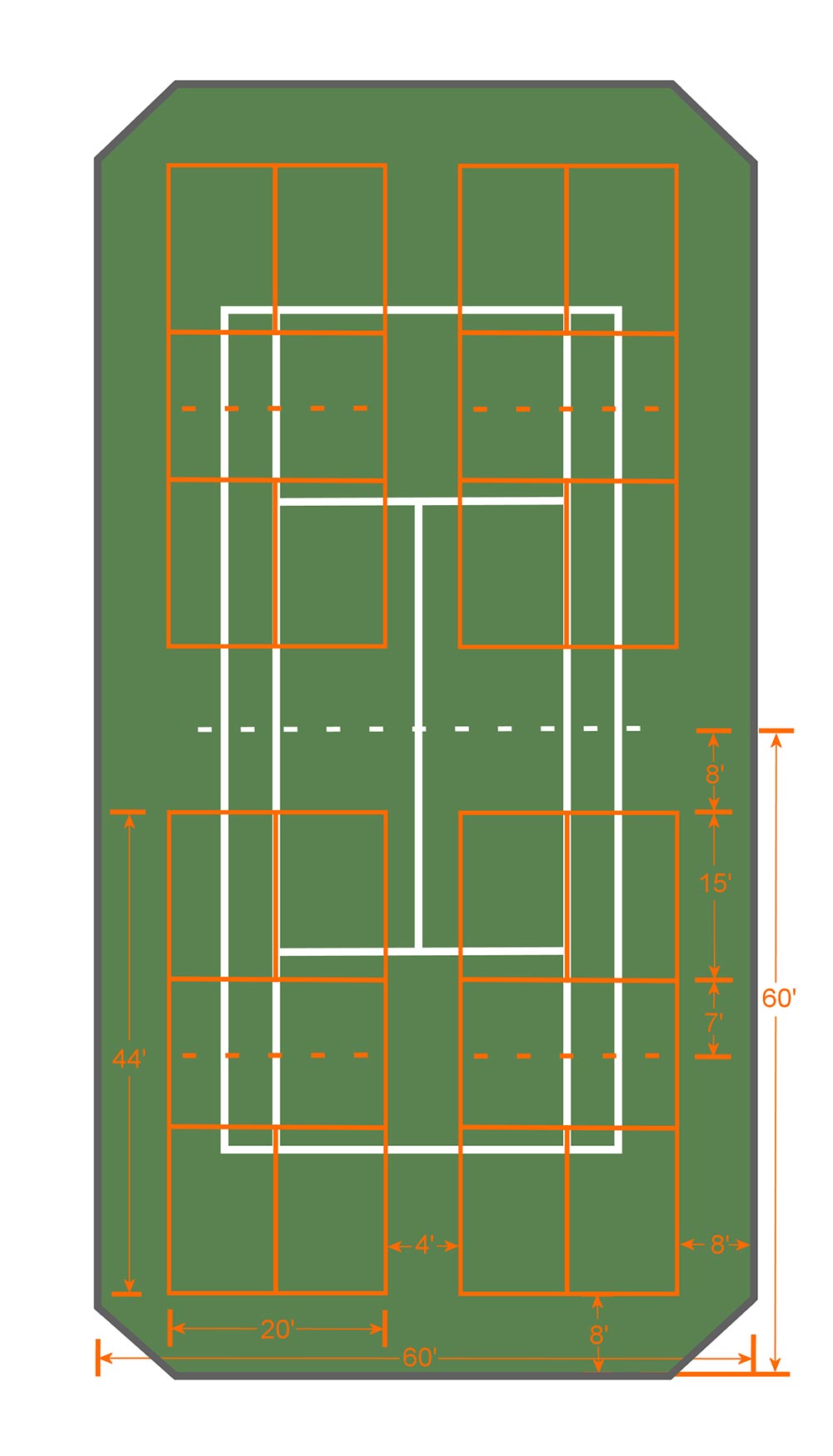
- Situation of Courts: Arrange four pickleball courts side-by-side with 4-foot barriers in between, ensuring safety and managing space efficiently.
- Detailed Lines and Markers: 2-inch wide lines for boundaries, non-volley zones, and service areas, painted in a contrasting color. The setup resembles organizing various office cubicles within a larger workspace, ensuring each cubicle retains its function without encroaching on others.
- Net Placement: Nets should meet official height and robustness specifications, maintaining equal tension and alignment.
By adhering to these guidelines, you create a well-structured, multi-court setup conducive to simultaneous matches while optimizing available space.
Frequently asked questions
Q: How small can a pickleball court be without sacrificing playability?
A: While the regulation size is 20 feet x 44 feet, smaller playing areas can be created in tighter spaces. However, consistently marking key elements like the non-volley zone and service areas maintains game integrity.
Q: What is the cost of constructing a pickleball court?
A: Costs vary based on surface type, materials, and additional features like fencing or lights. On average, it could range from $15,000 to $30,000 for a basic court. Higher-end materials or amenities, such as cushioned surfaces or professional-grade fencing, can increase costs considerably.
Q: Can multiple pickleball courts co-exist comfortably within larger sports complexes?
A: Yes, facilities like tennis courts, gymnasiums, or large outdoor fields can easily accommodate several pickleball courts, making them versatile multi-sport venues.
Q: How does the net height impact gameplay?
A: The net’s varying height (36 inches at the ends, 34 inches at the center) adds an additional layer of challenge and skill, particularly in serving and volleying.
Q: What is the preferred surface type for professional pickleball games?
A: Acrylic-coated concrete surfaces are often preferred in professional play, offering durability, sufficient cushion, and consistent ball bounce.
In conclusion, understanding the dimensions, layout, and composition of pickleball courts is essential for players and facilities alike. The game’s accessibility and fun lie in these carefully planned details, ensuring it remains enjoyable for everyone, from novices to seasoned pros.
